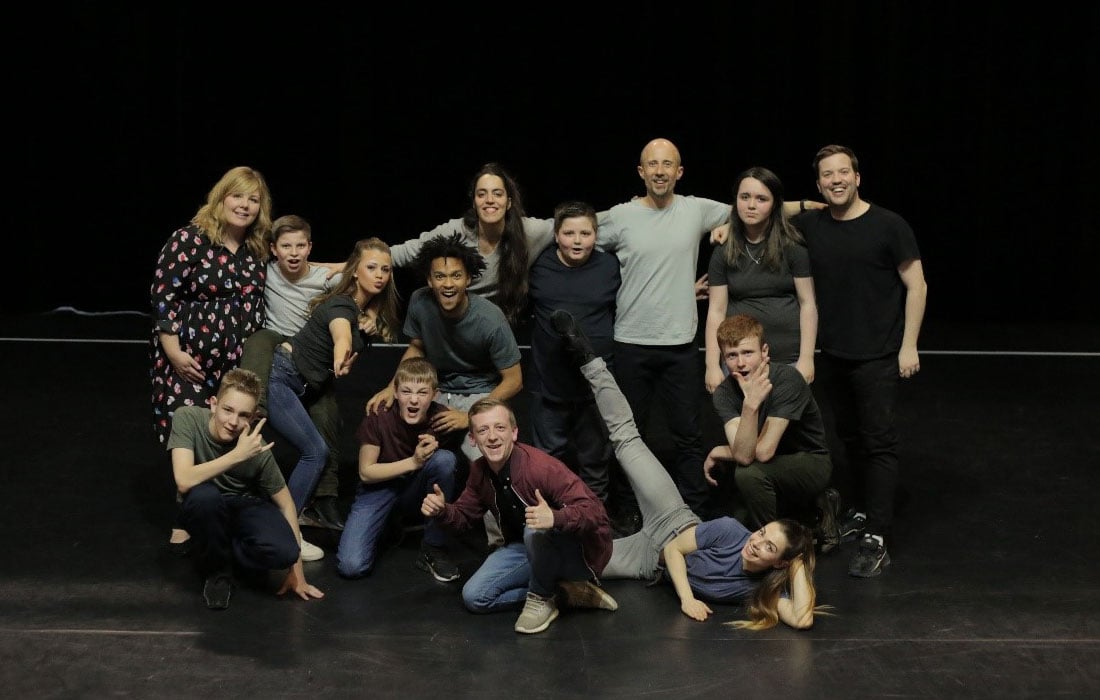
Young people, Protein Dance artists and teachers from Bishopton Pupil Referral Unit at ARC, Stockton-on-Tees
Photo: © Davey Porenba
Dancing to a new tune
A programme in Stockton-on-Tees has helped young people excluded from mainstream schools learn new skills, develop self-worth and show others what they can achieve, writes Rachele Rapisardi.
For over 15 years Protein has been making dance work that focuses on those who can be invisible in our society. Our artistic director Luca Silvestrini has developed Real Life Real Dance, a programme that uses dance to make a real difference to people’s lives. It provides a creative outlet for people who are displaced and disengaged. We have worked with children and young people in pupil referral units and hospitals, as well as with older people in care homes and refugees.
It expands their belief in what they can achieve and it shows them at their best
Over the past five years the company has developed a connection with Stockton-on-Tees, an area in the bottom 10% of the national indices of deprivation and a recognised ‘cold spot for dance’. In March, together with three Protein dance artists, I returned to work with Bishopton Pupil Referral Unit and ARC, the local arts centre.
Over an intensive three-week residency at ARC we worked alongside participants to create a performance for family, friends and school staff. The project was accredited, and students gained a Bronze Arts Award qualification.
Tools and skills
As a dance artist I ask myself how I can share with the community what contemporary dance has done for me. Young people who are excluded from mainstream schools are required to go through a major change in their lives. On top of this they are also often affected by ongoing stressful situations and traumatic experiences. This performance-led dance project offers many tools and skills that help them cope with these issues.
The main tool is dance, which incorporates moving, having fun, releasing tension, changing posture and opening up the body to the outside. Over the three-week project, we tackle topics such as wellbeing, diet (during breakfast club and lunch), discipline and teamwork. And alongside dancing itself, it's discipline and teamwork that makes this a successful project. The professional dance artists and the young people create a dance company in which we learn how to work together, support and trust each other, and solve issues when they arise.
We do that through different activities, sometimes physical (dancing) and sometimes group discussions or one-on-one conversations. For discovering and physically experiencing trust, support and teamwork, the best activity is contact work. This is a specific field of contemporary dance that focuses on sharing weight and learning how to let go of or receive one’s weight. It is extremely effective in creating bonds, trust and mutual support among people, without having to actually talk about it.
Personal and group goal-setting is another helpful tool. The young people decide on rules for the space, are consulted on scheduling and set their own goals. At weekly one-to-one meetings, these goals are articulated and documented, and the following week they are reflected upon. The young people are also asked to identify how they would achieve each goal.
Another powerful tool is learning pre-set dance sequences and developing these phrases of movement together. Learning dance motifs expands participants' dance knowledge, establishes a sense of discipline in how the steps are executed, and nurtures a sense of achievement. Creative sessions can empower the young people. They apply what they have learnt, develop their creativity and explore their individuality, while feeling ownership and responsibility over the work.
Group discussions and one-to-ones are usually a time for reflection, to become aware of what has been done and achieved, and what can be improved and how. Often the content of the show is relevant to the process and the dancers, so spoken and written activities (as well the actual dancing) are helpful in exploring this.
Professional performance
Producing a performance is not only the aim of the project, but alsoprovide a strong guide and motivation for the company. For the participants this element is fundamental in creating a sense of achievement and pushing them to a professional level. It expands their belief in what they can achieve – often more than what they think they can – and it shows them at their best.
Their success is witnessed by their teachers, parents and carers, who might have never seen the young people in this light before. This part of the process often raises the self-esteem and confidence of the young person and all those who support them. We don’t expect to change their life, but what this experience does effectively is give them access to different options and choices. We can share tools and skills that might help them deal with the stress and changes they go through. They experience self-worth, success and, maybe not immediately but at some point in the future, they might remember and feel like they have more options available, and that they can achieve what they want if they put their minds to it.
There’s nothing more rewarding than seeing the benefits, both practical and emotional, experienced by participants and their families at the end of these projects. While it can be challenging, we’ve found the key is to stay true to the artform, and apply the same thorough professional standards we apply to all our work. We achieve positive results by being artists and by letting our artistic practice do its job.
Rachele Rapisardi is Associate Director and Lead Dance Artist at Protein.
www.proteindance.co.uk
Tw @proteindance
Join the Discussion
You must be logged in to post a comment.